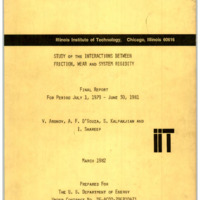-
Title
-
Study of the Interactions Between Friction, Wear and System Rigidity
-
Description
-
This study was undertaken to investigate the interrelationships between system rigidity and friction and wear. A special apparatus was designed and constructed where the system rigidity could be changed, and experiments were ccnducted with water lubrication and also under dry conditions. During experiments the wear rate, friction force and normal force oscillations as well as slider vibrations were measured and analyzed. The samples of work surfaces were subjected to the light and scanning electron microscopy analysis and Talysurf roughness measurement. These analyses have shown that three main regimes of friction exist as a function of system rigidity, namely, a) "steady state" friction associated with the smallest rate of wear, b) friction with "self-disturbances" causing highest rate of wear and c) regime of self excited vibrations. The wear behavior and slider vibration in tangential and normal directions are analyzed for all three friction regimes. :
-
Creator
-
Aronov, V.
-
D'Souza, A. F.
-
Kalpakjian, S.
-
Shareef, I.
-
Date
-
1982
-
Date Issued
-
1982-03
-
Extent
-
149
-
Corporate Author
-
Illinois Institute of Technology
-
Laboratory
-
U. S. Department of Energy
-
Report Number
-
DOE/ER/10471-2
-
Contract
-
DE-AC02-79ER10471
-
NTRL Accession Number
-
DE82009528
-
Distribution Conflict
-
No
-
Photo Quality
-
Not Needed
-
Distribution Classification
-
1
-
Report Availability
-
Full text available
-
Abstract
-
This study was undertaken to investigate the interrelationships between system rigidity and friction and wear. A special apparatus was designed and constructed where the system rigidity could be changed, and experiments were ccnducted with water lubrication and also under dry conditions. During experiments the wear rate, friction force and normal force oscillations as well as slider vibrations were measured and analyzed. The samples of work surfaces were subjected to the light and scanning electron microscopy analysis and Talysurf roughness measurement. These analyses have shown that three main regimes of friction exist as a function of system rigidity, namely, a) "steady state" friction associated with the smallest rate of wear, b) friction with "self-disturbances" causing highest rate of wear and c) regime of self excited vibrations. The wear behavior and slider vibration in tangential and normal directions are analyzed for all three friction regimes. :
-
Provenance
-
IIT
-
Type
-
report
-
Date Modified
-
Scanned and posted 2023-10-03
 DOE/ER/10471-2
DOE/ER/10471-2